
Weeds
Weeds are a very common headache and trying to remove them and prevent further growth can be the bane of many gardeners’ lives. Here we take a deep dive into this common garden problem, what makes a weed a weed, what weeds are common, how to remove weeds and do they bring any benefits at all for gardeners.
What makes a plant a weed?
In simple terms, a plant becomes a weed when it is not wanted. Though there isn’t any formal definition of what counts as a weed, there are certain characteristics of weeds that make a plant more likely to be one, for example:
- The plant grows in a place different to its natural habitat
- It is able to flourish despite the surrounding conditions being inhospitable for other plants.
- They can grow and reproduce aggressively
- The plants seeds can lay dormant in the soil for a very long time.
It is these final two characteristics in particular that can make a weed problem difficult to remove even after the initial plant has been killed. It is also important to consider not every plant is a weed in certain contexts and the main question you should be asking is whether this plant belongs here or not.
What problems can weed cause?
Some weeds can be disliked simply because they are not very attractive to look at. A lawn which would otherwise be pristine becomes a lot less appealing when it is littered with weeds.
However, weeds if left on their own can cause much further problems for your garden.
Weeds compete with surrounding plants for resources such as sunlight, moisture and nutrients which can cause the other more desirable plant to die.
Aggressive growth of certain weeds can cause structural damage to buildings, the most known example is Japanese Knotweed which can cause massive structural damage. This can also be costly if the plant spreads beyond the boundaries of your land and affects someone else’s property as they may be entitled to compensation for the damage. A news report in July 2022 shows that a family received £6,000 in compensation from Network Rail after Japanese Knotweed had grown into their land and damaged the property.
Some weeds can also devalue your property should you wish to sell it in the future.
Other weeds such as nettles and giant hogweed can sting and irritate the skin if you are in close proximity. Finally, weeds can also be a great hiding place for garden pests such as spider mites, aphids or mealy bugs may hide in there.
Are there any benefits to weeds?
Though weeds can cause significant problems, there can be some benefits as well. Stinging nettles have a variety of uses and can be used in nettle soups and teas, though if you try this recipe and decide to go foraging, be sure to wear thick protective gloves! Some weeds can be used to repel pests. Even Japanese Knotweed is said to taste similar to rhubarb.
What are classifications of weeds?
Broadly, weeds can be sorted into four different categories based on their growing cycle:
- Annual Weeds have a year-long growth cycle. They usually appear in the springtime and hang around until winter sets in and they die. For more weeds to grow, seeds and cuttings from the old plant have to be harvested. Fat hen, charlock and meadow grass are examples of these.
- Perennial weeds have a life cycle that lasts longer than one year. They tend to be sturdy and even if you pull them up, they hang around if the taproot remains in the ground. Their cycle is usually to grow over spring and summer, die in the autumn and winter and then regrow from their rootstock the following year. An example of these would be dandelions.
- Ephemeral weeds have multiple life cycles per year. They can reproduce quickly within a short time and examples include chickweed and groundsel.
- Biennial weeds usually have a two-year growing cycle and can be difficult to get rid of, including hemlock and ragwort. They usually grow in the first year before going dormant in the winter, in the second year they will flower and produce seeds and then die. However Biennial plants can act as though they perennials as the new plants that produce from the seeds constantly replace the plants that have died after their second year.
What plants are considered weeds and how do you remove them?
There are many different plants which may be considered weeds with more than 500 types of weeds that can be found in lawns in the UK.
Common types of weed
Dandelion

Perhaps the most common lawn weed and most people will have memories of plucking these off the school field and making daisy chains. However, many gardeners consider daisies to be weeds. The daisy is a perennial and is effective at flowering and seeding in even the lowest cut lawns. The flowers can appear all through the year, but most noticeably in late spring to around the start of October. Daisies are the most common type of weed as they can grow pretty much anywhere on all types of soil. It is easy to remove daisies by hand or with shears if they are in a small area, however a weed killer is more effective if large portions of the lawn are invested.
Buttercup and Creeping Buttercup
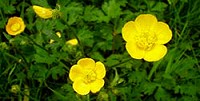 A perennial weed spread by seed, runners and creeping stems. Buttercups are resistant to mowing, very aggressive and difficult to shift. The only real solution is to use a professional systemic weed killer. Creeping buttercup will flower with bright yellow petals anytime from May until August.
A perennial weed spread by seed, runners and creeping stems. Buttercups are resistant to mowing, very aggressive and difficult to shift. The only real solution is to use a professional systemic weed killer. Creeping buttercup will flower with bright yellow petals anytime from May until August.
Plantain
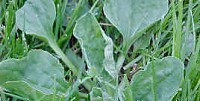 There are various species of plantain, which are commonly found on thin growing lawns. This broadleaf weed lies flat to the ground and is tolerant to trampling and mowing. Flowering from May to September, it produces masses of seeds that will re-infect the lawn in later years.
There are various species of plantain, which are commonly found on thin growing lawns. This broadleaf weed lies flat to the ground and is tolerant to trampling and mowing. Flowering from May to September, it produces masses of seeds that will re-infect the lawn in later years.
Ribwort
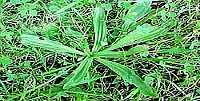 This perennial herb covers the lawn, cutting out light and water to the grass. Spreads quickly, but can be removed fairly easily by hand or systemic weed killer.
This perennial herb covers the lawn, cutting out light and water to the grass. Spreads quickly, but can be removed fairly easily by hand or systemic weed killer.
White Clover
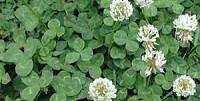 Thrives in a dry lawn, is very aggressive and difficult to shift. Spread by runners along the ground surface, so mowing has no effect. The flowers are white and appear between May and October. The only real solution is to use a professional systemic weed killer, or keep the lawn well watered and remove weeds by hand as soon as you see them.
Thrives in a dry lawn, is very aggressive and difficult to shift. Spread by runners along the ground surface, so mowing has no effect. The flowers are white and appear between May and October. The only real solution is to use a professional systemic weed killer, or keep the lawn well watered and remove weeds by hand as soon as you see them.
Daisy
 Perhaps the most common lawn weed. The daisy is a perennial and is effective at flowering and seeding in even the lowest cut lawns. The flowers appear all through the year, but most noticeably in late spring. It is easy to remove daisy’s by hand however a weed killer is more effective if large portions of the lawn are invested.
Perhaps the most common lawn weed. The daisy is a perennial and is effective at flowering and seeding in even the lowest cut lawns. The flowers appear all through the year, but most noticeably in late spring. It is easy to remove daisy’s by hand however a weed killer is more effective if large portions of the lawn are invested.
Mouse-Ear Chickweed
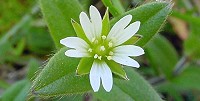 This annual can grow at an alarming rate up to 40cm long and is not killed by mowing. It has small white flowers (flowering April – September) and hairy oval shaped leaves. A selective weed killer is the best way to control this weed.
This annual can grow at an alarming rate up to 40cm long and is not killed by mowing. It has small white flowers (flowering April – September) and hairy oval shaped leaves. A selective weed killer is the best way to control this weed.
Yarrow
 Another difficult one to kill due to its very small leaves! This weed is poisonous to horses. The only real solution is to use a professional systemic weed killer – and even then it may take a couple of applications.
Another difficult one to kill due to its very small leaves! This weed is poisonous to horses. The only real solution is to use a professional systemic weed killer – and even then it may take a couple of applications.
Trefoil
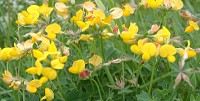 Very common in summer this low growing annual weed is able to survive the closest mowing and can reach lengths of up to 50cm. It has 3 small, oval shaped leaves and a small yellow flower, appearing between May and October. Can be removed by hand or with a professional systemic weed killer – and even then it may take a couple of applications.
Very common in summer this low growing annual weed is able to survive the closest mowing and can reach lengths of up to 50cm. It has 3 small, oval shaped leaves and a small yellow flower, appearing between May and October. Can be removed by hand or with a professional systemic weed killer – and even then it may take a couple of applications.
Speedwell
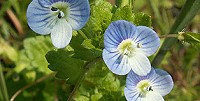 This common weed with creeping stems, it is capable of rapidly spreading through a lawn. It has small lilac flowers, with a white centre and flowers from April to June. The only real solution is to use a professional systemic weed killer – and even then it may take a couple of applications.
This common weed with creeping stems, it is capable of rapidly spreading through a lawn. It has small lilac flowers, with a white centre and flowers from April to June. The only real solution is to use a professional systemic weed killer – and even then it may take a couple of applications.
Thistle
 Easily removed by a good quality herbicide – don’t try pulling them out as you will almost certainly leave the roots behind.
Easily removed by a good quality herbicide – don’t try pulling them out as you will almost certainly leave the roots behind.
Lesser Celandine
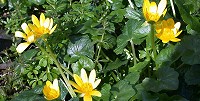 A low growing perennial with heart shaped leaves. Flowers between February and May with a single pure yellow flower. Repeated treatments with a selective weed killer will control this weed.
A low growing perennial with heart shaped leaves. Flowers between February and May with a single pure yellow flower. Repeated treatments with a selective weed killer will control this weed.
Other weeds within your garden can include:
- Nettles
- Bittercress
- Dock
- Bindweed
- Chickweed
- Groundsel
Different weeds have different lifecycles and only appear at certain times of the year. As a result of this the different weeds require different treatments. We use a wide range of selective herbicides that will kill these weeds without affecting the grass; all of which are professional products that are only available to trained and accredited professionals.
How to tackle a lawn overrun with weeds
It can often be surprising just how quickly weeds can get a foothold in your garden and even overrun it – even people who are very house proud who take excellent care of their lawns can find the odd unwanted weed among the grass.
If, however you have found you have come to a point where your lawn is more weed then grass it can seem like a hopeless task to return your lawn to its former glory but it is not impossible, the two main steps are to kill the existing weeds and then to prevent them from coming back again.
To kill the weeds, it is sometimes sufficient to just dig them up or pull them out by hand, but this is a hard and laborious task and needs to be done carefully to ensure you remove the entire plant. This is especially true for weeds such as Dandelions where the tap root will be very far down in the soil and even if a tiny bit is left it can be enough to allow the plant to regrow.
However, it is often better to use a herbicide as they tend to be more reliable and require less labour. You should choose a herbicide which will combat your lawn weeds without harming the grass itself however.
Once the garden seeds are destroyed however you then need to take steps to prevent the weeds from coming back, by making sure your lawn is healthy enough to hold them off, we recommend:
- Lawn feed – Fertiliser promotes strong, healthy grass growth and helps your lawn to resist weed growth.
- Careful mowing –You should mow your lawn regularly, but try not to cut the grass too short as it can make it easier for weeds to take hold. Be sure to follow the 1/3 rule of never cutting more than a third of your grass’s height in a single mowing session.
- Overseeding – Adding new grass seed to your lawn every couple of years keeps the grass from thinning out and ensures the weeds have no room to thrive.
Lawn 3 provides a professional lawn treatment service in the West Midlands and South Staffordshire areas. We can deal with a wide variety of lawn problems, including weeds so speak to our friendly team on 01384 70722 to find out how we can help you today.



